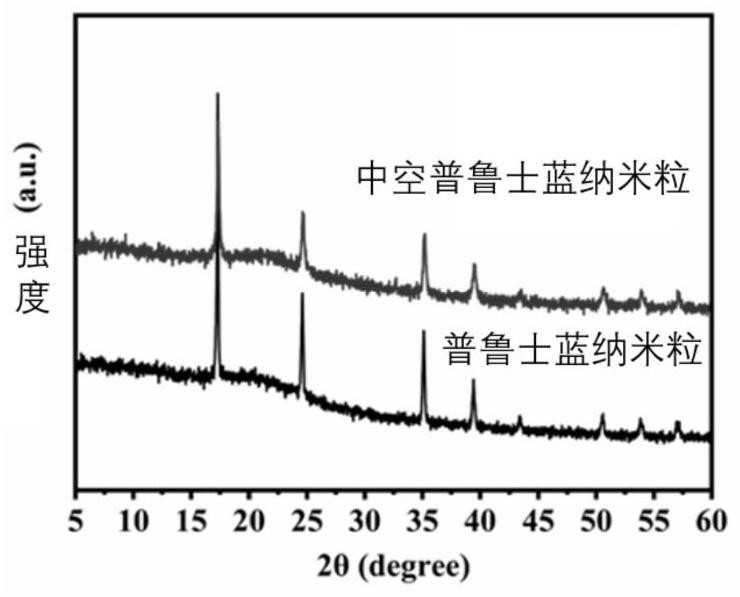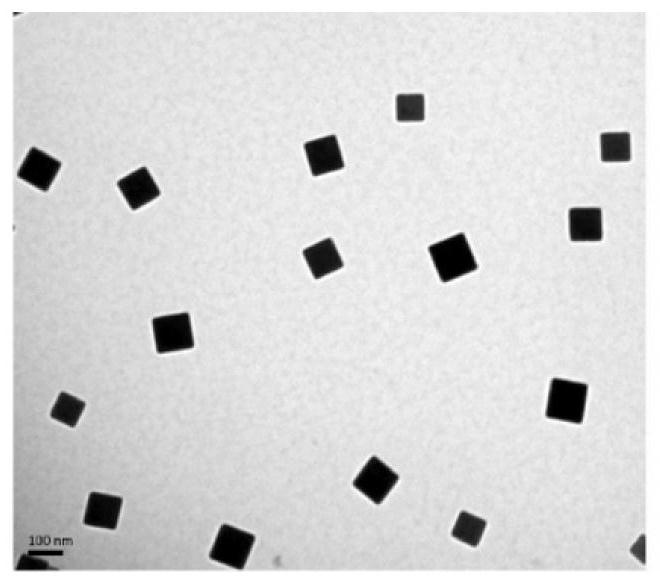Self-oxygen-supply hollow Prussian blue nanoparticle as well as preparation method and application thereof
A technology of Prussian blue and self-supplying oxygen, which is applied in the fields of medical formula, photodynamic therapy, medical preparations containing active ingredients, etc., can solve problems such as human side effects, weak anti-oxidation ability of hemoglobin, and reduced anti-tumor effect of PDT, etc., to achieve Effects of promoting apoptosis, improving oxygen supply deficiency, and increasing drug loading
- Summary
- Abstract
- Description
- Claims
- Application Information
AI Technical Summary
Problems solved by technology
Method used
Image
Examples
Embodiment 1
[0035] Example 1: Preparation of Prussian Blue Nanoparticles
[0036] Weigh 528 mg of potassium ferricyanide and 12.0 g of polyvinylpyrrolidone in a beaker, add 160 mL of hydrochloric acid with a concentration of 0.01 M, stir magnetically for 0.5 h, transfer the reaction solution to a 200 mL reaction kettle, and place it in an oven at 80 °C for constant temperature reaction for 20 h After centrifugation, the obtained precipitate was washed three times with ultrapure water, and Prussian blue nanoparticles were obtained after freeze-drying (such as figure 1 shown).
Embodiment 2
[0037] Example 2: Preparation of hollow Prussian blue nanoparticles
[0038] 20 mg of Prussian blue nanoparticles obtained in Example 1 were weighed and dispersed in 20 mL of hydrochloric acid solution with a concentration of 1 M, and 100 mg of polyvinylpyrrolidone was added. Then the reaction system was placed in an oven and reacted at 140° C. for 4 h. After the reaction, the hollow Prussian blue nanoparticles were collected by centrifugation, washed 3 times with deionized water, and then freeze-dried to obtain the hollow Prussian blue nanoparticles (such as figure 1 shown).
[0039] According to the X-ray diffraction patterns of the products of Example 1 and Example 2 ( figure 2 ), the positions of all diffraction peaks correspond to the diffraction surfaces of Prussian blue nanoparticles, respectively, showing the formation of Prussian blue nanoparticles; TEM images of Prussian blue nanoparticles ( image 3 ), it can be seen that the Prussian blue nanoparticles have a u...
Embodiment 3
[0040] Example 3: Loading of Drugs
[0041]Take 5 mg of the lyophilized powder of hollow Prussian blue nanoparticles prepared in Example 2 in a flask, add ultrapure water to disperse. Weigh an appropriate amount of hemoglobin into a centrifuge tube, add ultrapure water to dissolve to a concentration of 1 mg / mL, drop 5 mL or 10 mL of Hb solution into the flask dropwise, and stir for 12 h in the dark under nitrogen atmosphere. After the reaction, centrifuge, add ultrapure water and wash 2 times to obtain self-oxygenated hollow Prussian blue nanoparticles loaded with hemoglobin (such as figure 1 and Figure 5 shown). Weigh 5 mg of IR783 into a brown glass bottle, add an appropriate amount of ultrapure water to dissolve, and prepare a solution of IR783 with a concentration of about 200 μg / mL. Then weigh 5 mg of hemoglobin-loaded self-oxygenated hollow Prussian blue nanoparticles into a beaker, and add ultrapure water to disperse. Subsequently, the IR783 solution was added drop...
PUM
| Property | Measurement | Unit |
|---|---|---|
| particle size | aaaaa | aaaaa |
| particle size | aaaaa | aaaaa |
| particle size | aaaaa | aaaaa |
Abstract
Description
Claims
Application Information
 Login to View More
Login to View More - R&D
- Intellectual Property
- Life Sciences
- Materials
- Tech Scout
- Unparalleled Data Quality
- Higher Quality Content
- 60% Fewer Hallucinations
Browse by: Latest US Patents, China's latest patents, Technical Efficacy Thesaurus, Application Domain, Technology Topic, Popular Technical Reports.
© 2025 PatSnap. All rights reserved.Legal|Privacy policy|Modern Slavery Act Transparency Statement|Sitemap|About US| Contact US: help@patsnap.com



